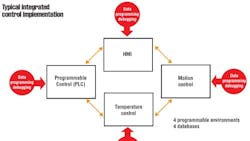Manufacturers of motioncontrol devices know motion and can provide powerful tools for the designer. But they often struggle to provide the right tools for logic and human machine interface (HMI) connections. A typical multipurpose programmable controller, on the other hand, easily handles logic functions but its positioning tools often fall short of the needed motion features. And many HMI devices simply display the logic and motion data. Thus, it's usually up to the designer to integrate these devices into a complete motion control system.
PC-based control, however, is changing all this. And it's doing it through an integrated programming environment and a common database for parameters.
Traditional motion
Most motion control solutions consist of a PLC, HMI device, and a motion controller with its DSPs and dedicated microprocessors. If the application involves complex motion profiles tightly synchronized with the associated logic, such a system can be a nightmare to program. The designer may face as many as five separate programming environments andtheir databases.
In addition, designers must integrate the associated communication drivers. This is often a difficult task because the drivers may be limited in the parameters they can access. And it can take hours of programming just to establish communications.
After these tasks are accomplished, however, designers must still synchronize the newly integrated system with the process. Add a vision system on top of this, and you can plan on getting tangled in a nasty web of programming.
Debugging can be even more difficult as the system may not offer the proper tools for real-time viewing of parameters as they pass between the three components.
Less is more
A better alternative is PC-based motion control. Though it's not new, PC-based motion has recently begun to play a prominent role in applications that integrate multiple functions. The first push came from car makers who helped drive motion and CNC control to the PC backplane. More recently, other users have pushed for the integration of humanmachine interfaces and serial communication functions.
Today's PC software packages that support motion typically rely on a separate motion card plugged into the backplane. They accept encoder input and send bi-polar reference signals to servo amplifiers to close the motion loop. This lets motion commands trigger from the software, so they can be more tightly synchronized with the other control functions in a process. What's more, because this is all done in a PC it simplifies programming.
If the PC also has an integrated operator interface editor, designers can display motion parameters as well with minimal programming. Communications are already established between the individual functions.
With combined databases, engineers need only point and click to access any data from the motion, logic or HMI portions of the system. This can save hours if not days in programming since all parameters are available to all editors.
In addition, PC-based control solutions can be less expensive. Savings on the order of 50% for a three-axis system are common.
The flow of programming
One of the benefits of PC-based motion control is use of an easier programming language known as flowchart. Flowchart programs are inherently state-oriented, yet they allow engineers to create sequences and tasks that are process oriented. In a sequence, a programmer can check a serial device, such as a bar code reader, make a logical decision, initiate a motion command to the motion control card, and evaluate whether the move was completed. Imagine doing the same programming task in three or more separate control boxes.
The flowchart environment also provides inherent diagnostics. Every decision block juncture can trigger an error message or corrective action depending on whether it receives the expected result. Debugging a program is easier because of the graphical nature of these programs. And since logic, motion, and display information are written in a single environment, the entire system can be debugged at one time.
When looking at PC-based control packages, look for one with all the features an application needs already built in. The key evaluation criteria should be the degree of integration of these features and whether they can share a common database. This will save time when solving interprocess communications problems.
The motion controller card should support all required motion functions, such as electronic camming and step functions, and, more importantly, so should the PC software package. Many packages support only a subset of these features, which forces engineers to use separate programming environments.
Gary Marchuk is product manager of PC Controls at Think & Do Software, Ann Arbor, Mich.
